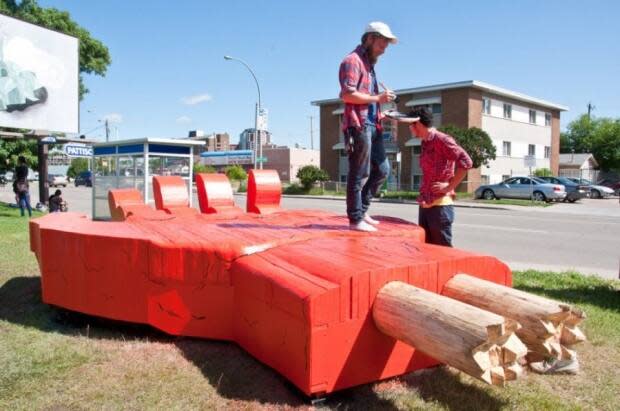Red hand sculpture to be removed from City of Edmonton's art collection
A large wooden sculpture of a severed red hand has sat on the northeast corner of 96th Street and 104th Avenue for years, but it won't be there for much longer.
Over the past eight years, despite efforts from the Edmonton Arts Council's conservation team, the wood has deteriorated to the point of posing a danger to public safety.
Once an interactive — and provocative — piece of public art, the hand is now fenced-off and scheduled to be permanently removed from the inner-city intersection on Wednesday morning.
The art world calls this deaccession: the process of removing an object from a collection forever.
Deaccessioning is rare, at least for the Edmonton Arts Council.
Public art and conservation director David Turnbull, who has worked for the organization for 11 years, could recall only two other pieces meeting the same fate.

Many deaccessioned works are sold or destroyed, but in this case, the hand will return to the man who made it.
Nickelas Johnson created the sculpture in 2012 for Dirt City: Dream City, an exhibit in the Quarters district, just east of downtown.
Before creating their works, he and the other participating artists spent a week learning about the area's history from Indigenous elders and community members.
"They were feeling cut off from the rest of the city and that what they had to offer wasn't as visible to the rest of the city," Johnson said Monday in an interview with CBC Edmonton's Radio Active.
His sculpture's official name is Ripp'd Off & Red.
In his artist statement, Johnson explained the sculpture's red colour refers to the overt racism that pushed Indigenous peoples "to the outskirts of our society."
Though not without its critics, the giant red hand was a conversation starter, even before it was finished being installed.

While Johnson was assembling the pieces on the southwest corner of Jasper Avenue and 95th Street, a steady flow of people asked him about the art and were quick to share their own interpretations.
This popularity prompted the City of Edmonton to buy the sculpture and keep it in the neighbourhood.
"There are so many different ways of engaging with public artwork that go beyond just looking at the thing," said Turnbull, who cherishes a family photo of his young parka-wearing son nestled in the hand's palm.
Johnson said he knew the sculpture would not be able to withstand the elements indefinitely but he was happy people enjoyed interacting with it while they could.
He plans to move the sculpture to an outdoor gallery he is assembling on his parents' property.

